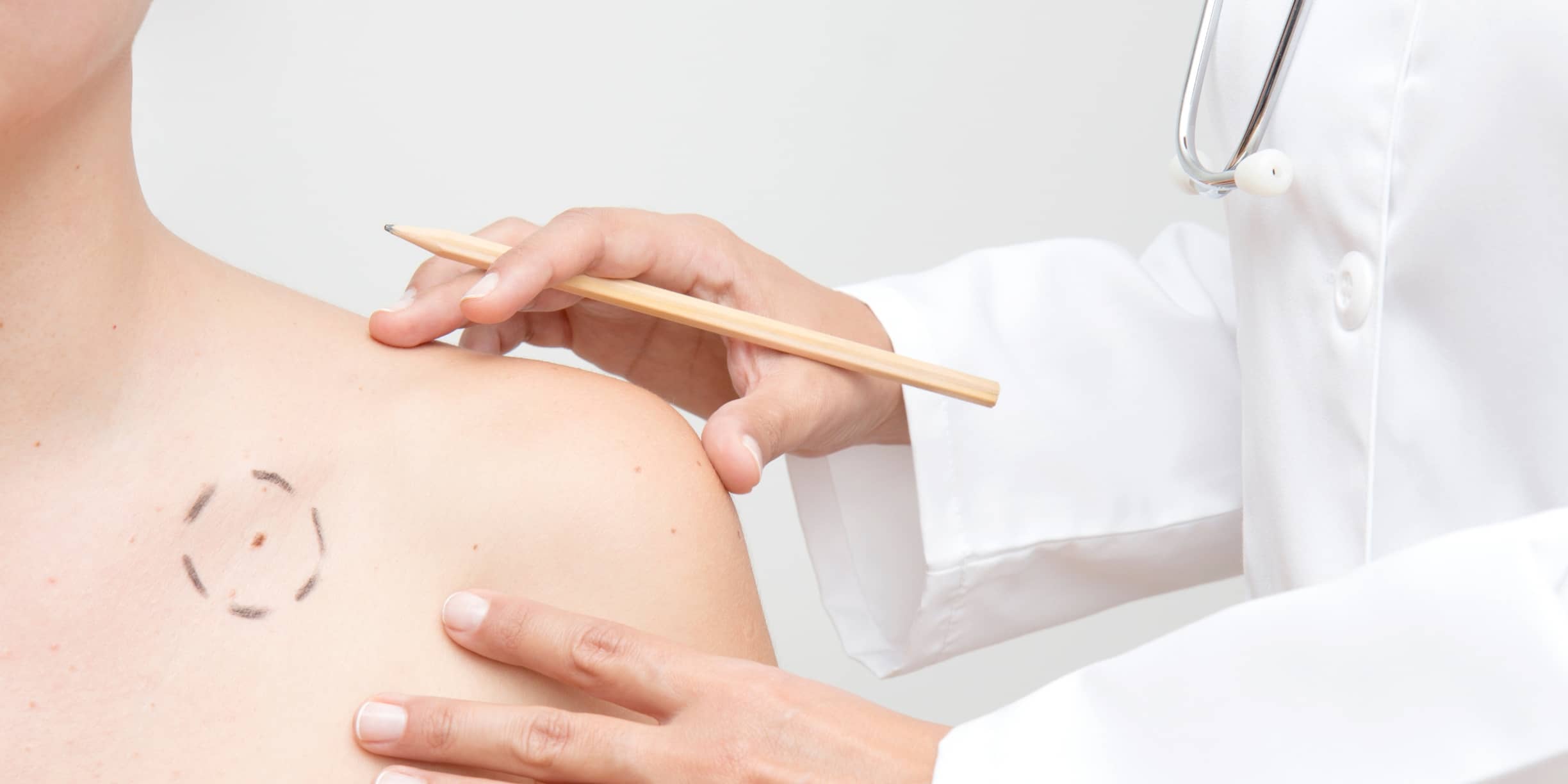Melanoma 101: All About Skin Cancer

Dr. Jason Sellers
One of the main functions of the skin is protection. It helps protect our bodies from external factors such as bacteria, chemicals, and physical injury. It also helps protect us by regulating body temperature, preventing water loss, and providing a sense of touch. But even though our skin protects us, we must “protect” our skin — specifically from the sun’s harmful ultraviolet radiation.

June and July mark the start of summer: the end of school, warmer and more humid temperatures in the northeast, maybe summer camp for the kids, and hopefully a chance to take a vacation with family or friends.
For many people, this time of year is a chance to relax, recharge, and enjoy the warmer weather. It is also when visiting the doctor’s office is the last thing on our minds.
However, even though we can wait for the fall for our annual physical, there are important health issues to consider during the summertime. One is making sure we stay hydrated in the summer heat. Another is taking care of our skin, which happens to be the largest organ in our body!
Why Do I Need To Protect My Skin?
One of the main functions of the skin is protection. It helps protect our bodies from external factors such as bacteria, chemicals, and physical injury. It also helps protect us by regulating body temperature, preventing water loss, and providing a sense of touch. But even though our skin protects us, we must “protect” our skin — specifically from the sun’s harmful ultraviolet radiation.
As we plan on spending more time in the sun this summer, we need to be wary to limit exposure to the sun and wear sunscreen as much as possible. If you’ve been to a dermatologist’s office, you may be aware that many common skin conditions, from age spots to skin cancer, are caused by or made worse by the effects of the sun. We’ll briefly discuss skin cancer to give some context about why this is so important.
What Is Skin Cancer?
Skin cancer, like other cancers, occurs when normal cells become abnormal, causing uncontrolled growth that requires treatment and, in some cases, can be life-threatening.
There are three main types of skin cancer:
- Basal cell – A slow-growing type of cancer that is often found on areas of exposed skin like the face and arms
- Squamous cell – This is the second most common type of skin cancer. If caught early enough, most squamous cell cancers are curable.
- Melanoma – This is a faster-growing type of cancer. Melanoma is less common than other types of skin cancer.
Basal and squamous cell cancers are easily treated as they are slow-growing. However, it is vital to treat them promptly to prevent further complications. Melanoma is another more serious form of skin cancer that can occur anywhere and run in families. This type of cancer has a greater risk of spreading to internal organs.
Where Does Skin Cancer Occur?
Melanoma and other skin cancers can occur anywhere on the body. However, it tends to occur more frequently on sun-exposed areas such as the head, face, neck, arms, and legs. This happens because skin cancer is caused by sun exposure and sunburn, the effects of which add up over time.
Moles to Worry About
Moles to be concerned about are ones that are darker in color and look like a brown or black mole or birthmark. Melanoma is usually darker in color. Certain features distinguish it from other moles or birthmarks.
These can be remembered by the mnemonic ABCDE: Asymmetrical shape, Border irregularity, color is uneven or splotchy, Diameter is larger than a pea, and Evolution or changing over the past few weeks or months.
Basal and squamous cell cancers can look very different, ranging from areas of pinkness, redness, swelling, peeling, bleeding, or crusting. Frequently these types of cancers look like cuts or scratches that never heal or go away over many months. They are often preceded by scaly, rough, or bumpy spots known as “actinic keratosis,” which are pre-cancerous and can easily be treated by your dermatologist to prevent the development of skin cancer.
How is Skin Cancer Diagnosed?
If you see a mark or mole on your skin that is new, unusual or changing, or if you seem to have a wound that does not heal over several months, you should see your primary care doctor or dermatologist.
Many benign and harmless skin conditions can be confused with skin cancer, but if there is any question, your doctor can examine and check for skin cancer. Your doctor may also want to do a biopsy.
A biopsy is a procedure where a small piece of skin is taken and sent to the lab to look under a microscope to see if the cells look normal or abnormal. This is the gold standard and can usually determine whether you have skin cancer or not.
If you have light hair and fair skin, it is a good idea to discuss regular skin cancer checks with your doctor, as this may put you at higher risk for the damaging effects of the sun.
How Is Skin Cancer Treated?
Skin cancer and pre-cancerous changes can be treated in many ways. Most commonly, these spots are treated with surgery where the cancer is removed, and in some cases, an area around the spot is also removed. Currently, physicians can use high-precision techniques to minimize scarring.
Other treatment options for skin cancer may include:
- Radiation therapy – Uses radiation to kill cancer.
- Chemotherapy – These are drugs that are used to treat cancer.
- Surgery – In some cases, doctors may perform surgery to remove cancer.
- Immune therapy – Uses the body’s immune system to kill cancer cells. It’s also called biological therapy.
How Can I Prevent Skin Cancer?
There are several things that you can do to prevent skin cancer.
Protect Your Skin
As discussed above, the best way to prevent skin cancer is to protect your skin. Especially in the summer, try to stay out of the sun in the middle of the day, from 10 AM to 4 PM. During this time, ultraviolet rays from the sun are strongest. If you need to be out, try staying in a shady spot and cover yourself as much as possible, for example, with sunglasses, a hat, a long-sleeved shirt, or long pants. Sunglasses are essential because they can help protect from developing eye conditions such as cataracts or macular degeneration.
Use Sunscreen
Sunscreen is also the most important. For the best protection, choose a sunscreen that is SPF 30 or higher, has “broad spectrum” protection against UVA and UVB, and is not expired. And remember that you don’t just need to apply it on sunny days at the beach – you should apply it on all exposed areas of skin even if it is cloudy, and also on the face all year long.
Wearing sunscreen will help prevent sunburn, and throughout a lifetime with helps prevent signs of aging and skin cancer. It’s also essential to remember that tanning is a risk factor for skin cancer, whether in the sun or on a tanning bed. Aiming to get a “base tan” does not protect your skin from further damage and adds to the long-term risks of sun exposure.
Do Sunburns Cause Skin Cancer?
Though one episode of sunburn is unlikely to cause skin cancer on its own, it’s important to remember to protect yourself in the future to prevent the cumulative effects over your lifetime.
Sunburns are treated depending on the severity.
- Mild – If it is relatively mild, you may not need anything more than cool compresses or over-the-counter lotions or sprays.
- Moderate – If the pain is more severe, you can take an over-the-counter pain reliever such as acetaminophen or ibuprofen.
- Severe – If you have severe sunburn, it may require immediate medical attention. This type of sunburn may be accompanied by a high fever, confusion, and vomiting.
The critical takeaway is to remember to wear sunscreen and protect yourself this summer! If you notice any new or changing skin spots or other unusual rashes, don’t hesitate to schedule an appointment or chat with your Radish provider to discuss further.
Request a Free Demo
Learn how Radish Health can help you improve employee health and save on healthcare.
Request a Demo